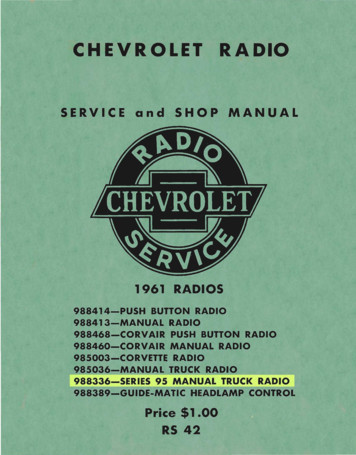TEXT ONLY Amateur Radio - FreeBSD Foundation
Map of stations and locations as seen by YAAC(west coast of USA).WSJTX used on 20meters.Typical antenna setupneeded without WSJT.With the increased power of moderncomputers, weak signal detection usingmodern digital signal processing hasimproved immensely. Joe Taylor, a NobelPrize-winning physicist who is also knownby his ham radio call sign K1JT, wanted away to send signals to the moon and back(Earth-Moon-Earth or simply EME or moonbounce) to send signals around the globevia the moon. Using his expertise in radioastronomy, he used modern advanced signal processing to develop Weak Signal JT(WSJT), using a new mode JT65. Early hamradio EME operations required very expensive and large antenna arrays with highpowered amplifiers. WSJT brings EME toamateurs using a more modest station thatis far less expensive to set up.Ham radio operators all over the worldnow use WSJT, WSJTX, and its offspring,WSPR, in daily use and to communicatewith very low power around the globe andnot just via the moon, but by traditionalWSJTX in so-called waterfall display showing region of frequencies vs. time.34 FreeBSD Journalshort wave using the ionosphere. (Seehttp://physics.princeton.edu/pulsar/K1JT/)A recent trans-Atlantic 2m attempt wasfound to have succeeded simply due tothe signals bouncing from theInternational Space Station, which justhappened to be in the right place at theright time! (July 14, 2014 seehttp://www.brendanquest.org/)PSK31 is a low-bandwidth mode that isalso very popular with modern hams. Itsability to be heard below the noise floormakes it very popular for low-power operators. Again fldigi is the program of choicehere for most hams.Amateur radio operators were instrumental in early work with packet radio,which has found its way into encrypteddigital systems for police and other emergency services. Store and forward networks using a modified X.25 protocol,AX.25, are still in use all over the world.This forms the backbone of the trackingsystem known as Amateur Positioning
View of stations in Ottawa Ontario, Canada using APRS asseen by http://aprs.fi.Radio System (APRS). This system is well supported from FreeBSD using Xastir and YAAC.Stations use GPS receivers to broadcast theircurrent positions via APRS over AX.25. This system is invaluable for volunteers using amateurradio who help the professionals who do searchand rescue—Civilian Air Patrol (CAP), for example. These signals are also relayed on theInternet to allow worldwide tracking of stations;e.g., http://aprs.fi/#!addr FN25 will show myneck of the woods in the Ottawa area.Software-defined radio is one of the hottestnew techniques being experimented with byradio amateurs. By using fast A/D converters,radio signals can be sampled directly from theair, converted to quadrature (two signals with a90 degree phase shift between them) digitalsamples, commonly referred to as I/Q signals tobe decoded using computers. For the radio,amateur signals can also be generated usingD/A converters and transmitted.When Adrian Chadd (ham radio call signKK6VQK, adrian@FreeBSD.org) wanted to lookat the layout of frequencies used by WiFi transmission, he needed a software-defined radio(SDR) package that was well supported. Thatmeant Adrian had to help port software tosupport the Ettus systems USRP to FreeBSD ifhe wanted to use it on his BSD systems withgnuradio. gnuradio is a software frameworkof components that can be linked togetherusing a graphical interface to put together SDRradio systems.High end RF A/D D/A systems can handlemany Mhz of frequencies at once, much as youwould have to do with radio astronomy or inWiFi signal analysis. However, much SDR can bedone using the standard audio card that comeswith any modern computer system or using aDVB-T TV tuner USB dongle based on theRTL2832U chipset. The sound card is limited tosampling baseband audio signals; hence, any RFsignals must be down converted to base bandbefore they can be decoded. The so-called“SoftRock” is a low cost RF converter that canbe used with programs such as QUISK to decodetraditional short wave modes including singlesideband (SSB), FM, and AM.A TV tuner USB dongle can be used to directly sample RF signals well up into the UHF radiospectrum, and as such can be used to monitorham radio frequencies in this spectrum or evenjust tune in a broadcast FM station; e.g., thertl-sdr port can be used in conjunction withgnuradio. Many ham radio enthusiasts havegnuradio-companion graphical interface being used to set up asimple DSP tutorial.gnuradio display of scope and fft plot of sample generator.July/August 201635
QSSTV program used to decode slow scan TV.gpredict satellite prediction program shows coverage areas ofsatellites being tracked.Early amateurradio builtsatellite AO-7.built-up converters to GNU Radioas used bygnuradio.org that convert low, short-wavereceived frequencies up into the region thata TV tuner dongle can receive.Ham radio operators have designed andbuilt their own satellites. AO-7, firstlaunched in 1974, is still going, albeit in aseverely degraded mode as the batterieshave now died.Building a satellite takes knowledge indiverse fields, such as power engineering,battery technology, radio, and embeddedcomputer systems. These are the sorts ofpeople who work for NASA. For the averageamateur radio operator, knowing where toaim the antenna and at what times for eachsatellite takes tracking software. Such programs as predict and gpredict are commonlyused here.The International Space Station has licensedamateur radio operators on board and in alow-earth orbit. It is a very easy station to hearwhen it is in automated mode and to talk towhen they are active. As can be expected, theastronauts on board don’t have a lot of timeto spare for talking directly to ham radio operators on the ground, but often will make special arrangements to talk to schools on theground. You can see this satellite listed in the36 FreeBSD Journalscreenshot of gpredict.Amateur radio television is a mode that isin use by some hams, though most of theactivity is with a low bandwidth form of television called slow scan TV (SSTV) SSTV in theearly days required surplus radar tubes witha long persistence (P7) phosphor that wasvery harsh on the eyes, but would allow thepicture to be painted before it faded.Nowadays, this is all done using computerdecoding and allows us full color pictures.The ISS has been known to broadcast SSTVsignals to the earth for ground stations toview as well.Repeaters are used to extend the distanceof mobile stations by putting a receiver on ahill or tall building along with a transmitterthat relays the signals from the mobile stations. It is a trivial matter to link local cityrepeaters across the world via the Internet.This can be done using thebridge orsvxlink.Amateur radio can be as technical as youwant it or just a relaxing hobby. There are somany diverse interests in the hobby with somany different aspects that I can only covera small part of it. The era of inexpensivecomputing has, and is, making amateurradio much more interesting. Perhaps youyourself now have an interest. For furtherreading I would suggest starting withhttp://www.arrl.org in the U.S. andhttp://www.rac.ca in Canada.DIANE BRUCE has done computer programming in one form or another for over 40 years,and has 35 years’ experience in embedded/real-time. Diane currently contributes to theFreeBSD Project, mostly in ports. Her hobbiesinclude amateur radio, writing, and music(amateur musician). She was first licensed as aradio amateur in 1968. db@Freebsd.org
ital modes, software-defined radio, and a myriad of other tasks. This has resulted in many applications written for amateur radio use, many written to . would have to do with radio astronomy or in WiFi signal analysis. However, much SDR can be done using the standard audio card that comes
Text text text Text text text Text text text Text text text Text text text Text text text Text text text Text text text Text text text Text text text Text text text
Mission Statement: The Brainerd Area Amateur Radio Club is comprised of about 85 licensed Amateur Radio Operators who meet monthly to exchange ideas, improve radio skills, organize activities that are of service to the area, promote development of Amateur Radio, and
Produced by The Cherokee County Amateur Radio Society, 1/23/2018, for non-profit, non-commercial use ONLY 2 T1A - Amateur Radio Service: purpose and permissible use of the Amateur
Building a security appliance based on FreeBSD BSDCan Ottawa 2019 1. Mariusz Zaborski 2 m.zaborski@fudosecurity.com oshogbo@FreeBSD.org https://oshogbo.vexillium.org @oshogbovx BSDCan Ottawa 2019. 3. 4 Data encryption. 5 Data encryption Storage. 6 Data encryption Storage External storage. 7 Data encryption Storage External storage Remote access .
Radio in the US only to 1936—but contains 184 pages. The 1800s—Prehistory The last few years of the 19th century set the stage for rapid development of commercial radio and established the foundations of Amateur Radio. There were numerous early contribu-tors to the radio art, such as the great Oersted, Ampere, Faraday, Henry, and others .
SERVICE and SHOP MANUAL 1961 RADIOS 988414-PUSH BUTTON RADIO 988413-MANUAL RADIO 988468-CORVAIR PUSH BUTTON RADIO 988460-CORVAIR MANUAL RADIO 985003-CORVETTE RADIO 985036-MANUAL TRUCK RADIO 988336-SERIES 95 MANUAL TRUCK RADIO 988389-GUIDE-MATIC HEADLAMP CONTROL Price 1.00 . 89 switch and must be opened by speaker plug when testing radio.
Wavestown Answer Key Radio Waves Ray’s TV - TV reception uses radio waves Satellite Dish on top Ray’s - receives movies via radio waves from a satellite Taxi - Car radio reception uses radio signals Taxi - Driver receives instructions on a CB radio which uses radio waves Radio Tower - broadcast’s radio signals
2nd Grade . ELA Priority Standards Grade 2 CCSS PA Core Foundational Skills RF.2.3 CC.1.1.2.D Know and apply grade level phonics and word analysis skills in decoding words. Distinguish long and short vowels when reading regularly spelled one- syllable words. Decode two-syllable words with long vowels and words with common prefixes and suffixes. Read grade level high-frequency .





















